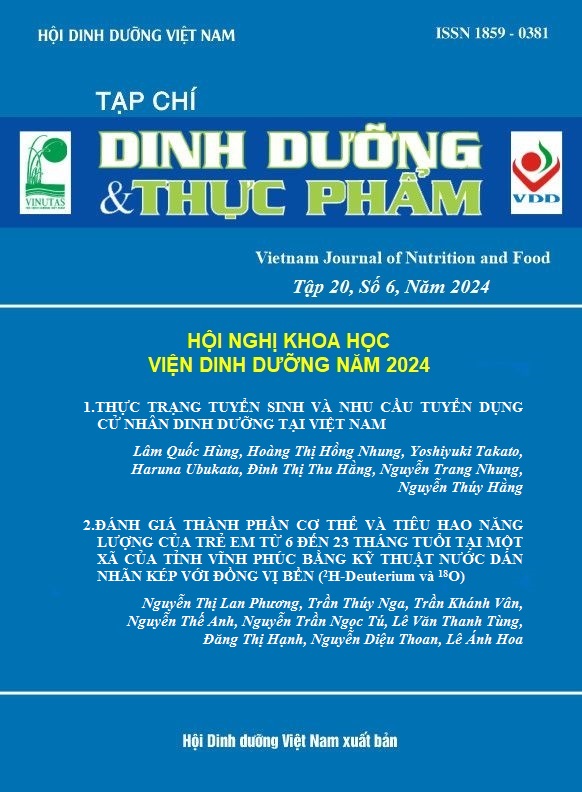THẨM ĐỊNH PHƯƠNG PHÁP XÁC ĐỊNH ĐỒNG THỜI 4-HYDROXYDERRICIN VÀ XANTHOANGELOL TRONG THỰC PHẨM CHỨC NĂNG BẰNG SẮC KÝ LỎNG HIỆU NĂNG CAO
Nội dung chính của bài viết
Tóm tắt
Mục tiêu: Thẩm định phương pháp xác định đồng thời 4-hydroxyderricin và xanthoangelol trong thực phẩm chức năng bằng sắc ký lỏng hiệu năng cao với detector mảng diod.
Phương pháp: 4-hydroxyderricin và xanthoangelol được chiết ra khỏi nền mẫu bằng cách siêu âm trong hỗn hợp methanol/nước (8/2) trong 30 phút và được tách bằng cột sắc ký pha đảo C18, pha động gồm methanol và nước. Tốc độ dòng là 1mL/phút, bước sóng của detector được cài đặt 370 nm.
Kết quả: Khoảng tuyến tính của 4-hydroxyderricin từ 4,7 – 235 µg/ml và xanthoangelol từ 5,35 – 267,5 µg/ml với hệ số tương quan R ≥ 0,9996. Giới hạn định lượng của 4-hydroxyderricin và xanthoangelol tương ứng là 0,24 mg/g và 0,35 mg/g. Phương pháp có độ thu hồi nằm trong khoảng từ 95,7 – 100,7%, với hệ số biến thiên (CV%) từ 2,9 – 4,6%.
Kết luận: Các thông số thẩm định của phương pháp đạt yêu cầu theo AOAC. Đây là phương pháp đơn giản, đáng tin cậy và có thể sử dụng để nghiên cứu và kiểm soát hàm lượng 4-hydroxyderricin và xanthoangelol trong thực phẩm chức năng.
Từ khóa
4-hydroxyderricin và xanthoangelol, thực phẩm chức năng, sắc ký lỏng hiệu năng cao
Chi tiết bài viết
Tài liệu tham khảo
2. Lindsay K Caesar, Nadja B Cech. A Review of the Medicinal Uses and Pharmacology of Ashitaba. Planta Medica.2016;82(14).
3. Zsuzsanna Rozmer, Pa´l Perje´si. Naturally occurring chalcones and their biological activities. Phytochemical Review.2016;15(1) :87–120.
4. Shanmei Xu, Minxiao Chen, Wenbo Chen, Junguo Hui, Jiansong Ji, Shuping Hu, Jianmin Zhou, Yi Wang and Guang Liang. Chemopreventive effect of chalcone derivative, L2H17, in colon cancer development. BioMed Central Cancer.2015;15:870.
5. Ewelina Szliszka, Dagmara Jaworska, Małgorzata Kłósek, Zenon P. Czuba and Wojciech Kró. Targeting Death Receptor TRAIL-R2 by Chalcones for TRAIL-Induced Apoptosis in Cancer Cells. International Journal of Molecular Sciences.2012; 13:15343-15359.
6. Hee Ryun Chang, Hwa Jin Lee, and Jae-Ha Ryu. Chalcones from Angelica keiskei attenuate the Inflammatory Responses by Suppressing Nuclear Translocation of NF-kB. Journal of Medicinal Food.2014;17(12): 1306–1313.
7. Nagata J, Morino T, Saito M. Effects of dietary Angelica keiskei on serum and liver lipid profiles, and body fat accumulations in rats. J Nutr Sci Vitaminol.2017; 53(2):133-7.
8. Li Yali, Luo Yulan, Liu Jianhua, et al. Determination of 4-Hydroxyderricin and Xanthoangelol in Different Parts of Angelica keiskei by HPLC-PDA. Journal of Food Science.2016;37(6):142-145.
9. Kil YS, Nam JW, Lee J, Seo EK. Separation of two major chalcones from Angelica keiskei by high-speed counter-current chromatography. Archives of Pharmacal Research.2015;38(8):1506-11.
10. Dae Wook Kim, Marcus J. Curtis-Long, Heung Joo Yuk, Yan Wang, Yeong Hun Song, Seong Hun Jeong, Ki Hun Park. Quantitative analysis of phenolic metabolites from different parts of Angelica keiskei by HPLC–ESI MS/MS and their xanthine oxidase inhibition. Food Chemistry. 2014;153:20–27.
11. Li Yali, Luo Yulan, Liu Jianhua, et al. Determination of 4-Hydroxyderricin and Xanthoangelol in Different Parts of Angelica keiskei by HPLC-PDA. Journal of Food Science.2016;37(6):142-145.
12. AOAC Official Method Analysis. Appendix F. Guidelines for Standard Method Performance Requirements. 2016,Appendix F, p.2.


